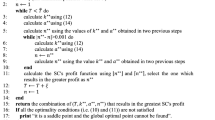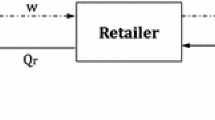Abstract
This research studies which discounts a supplier needs to offer to give incentive to his customers to change their order patterns in a way that minimizes the supplier’s total cost. Savings for the supplier arise from reduction of set up and inventory cost. Customers also profit from this since the total discount offered is greater than their total cost increase. This research assumes zero or low price elasticity of the demand, thus lower prices do not result in greater total demand, they only affect when orders will be placed. A heuristic solution is given by separating the problem into when orders should be placed and how much discount should be offered to make this order pattern the cheapest for the buyer and includes three steps.
Access this chapter
Tax calculation will be finalised at checkout
Purchases are for personal use only
Similar content being viewed by others
References
Busher, U., & Lindner, G. (2004). Ensuring feasibility in a generalized quantity discount pricing model to increase supplier’s profits. Journal of the Operational Research Society, 55, 667–670.
Chakravarty, A. K., & Martin, G. E. (1988). An optimal joint buyer-seller discount pricing model. Computers and Operational Research, 15, 271–281.
Chen, R. R., & Robinson, L. W. (2012). Optimal multiple-breakpoint quantity discount schedules for customers with heterogenous demands: all-unit or incremental? IIE Transactions, 44, 199–214.
Lal, R., & Staelin, R. (1984). An approach for developing an optimal discount pricing policy. Management Science, 30(12), 1524–1539.
Lee, H. L., & Rosenblatt, M. J. (1986). A generalized quantity discount pricing model to increase supplier’s profits. Management Science, 32(9), 1177–1185.
Monahan, J. P. (1984). A quantity discount pricing model to increase vendor profits. Management Science, 30(6), 720–726.
Rosenblatt, M. J., & Lee, H. L. (1985). Improving profitability with quantity discounts under fixed demand. IIE Transactions, 17(4), 388–394.
Wagner, H., & Whitin, T. (1958). Dynamic version of the economic lot size model. Management Science, 5(1), 89–96.
Author information
Authors and Affiliations
Corresponding author
Editor information
Editors and Affiliations
Rights and permissions
Copyright information
© 2014 Springer International Publishing Switzerland
About this paper
Cite this paper
Buhayenko, V., van Eikenhorst, E. (2014). Determining Optimal Discount Policies for a Supplier in B2B Relationships. In: Huisman, D., Louwerse, I., Wagelmans, A. (eds) Operations Research Proceedings 2013. Operations Research Proceedings. Springer, Cham. https://doi.org/10.1007/978-3-319-07001-8_11
Download citation
DOI: https://doi.org/10.1007/978-3-319-07001-8_11
Published:
Publisher Name: Springer, Cham
Print ISBN: 978-3-319-07000-1
Online ISBN: 978-3-319-07001-8
eBook Packages: Business and EconomicsBusiness and Management (R0)




